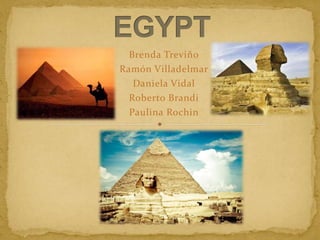
Egypt
- 1. Brenda Treviño Ramón Villadelmar Daniela Vidal Roberto Brandi Paulina Rochin
- 5. Daily life in ancient Egypt revolved around the Nile and the fertile land along its banks. The yearly flooding of the Nile enriched the soil and brought good harvests and wealth to the land.
- 6. The ancient Egyptians believed in many different gods. Each one with their own role to play in maintaining peace and harmony across the land. Some gods and goddesses took part in creation, some brought the flood every year, some offered protection, and some took care of people after they died. Others were either local gods who represented towns, or minor gods who represented plants or animals. They believed that it was important to recognize and worship these gods and goddesses so that life continued smoothly.
- 7. The ancient Egyptians believed that Ra was swallowed every night by the sky goddess Nut, and was reborn every morning. Since jackals were often seen in cemeteries, the ancient Egyptians believed that Anubis watched over the dead. The ancient Egyptians believed that Atum was the first god to exist on earth.
- 9. The most powerful person in ancient Egypt was the pharaoh. The pharaoh was the political and religious leader of the Egyptian people, holding the titles: 'Lord of the Two Lands' and 'High Priest of Every Temple'. As 'Lord of the Two Lands' the pharaoh was the ruler of Upper and Lower Egypt. He owned all of the land, made laws, collected taxes, and defended Egypt against foreigners. As 'High Priest of Every Temple', the pharaoh represented the gods on Earth. He performed rituals and built temples to honour the gods.
- 10. The structure was based upon the population, the sources of wealth, the farming and fishing, the manufacturing, the mining, the commerce and banking, energy, warfare, slavery, and taxation.
- 11. The ancient Egyptians built pyramids as tombs for the pharaohs and their queens. The pharaohs were buried in pyramids of many different shapes and sizes from before the beginning of the Old Kingdom to the end of the Middle Kingdom. There are about eighty pyramids known today from ancient Egypt. The three largest and best-preserved of these were built at Giza at the beginning of the Old Kingdom. The most well-known of these pyramids was built for the pharaoh Khufu. It is known as the 'Great Pyramid'
- 13. Symbolism: Symbolism also played an important role in establishing a sense of order. Symbolism, ranging from the pharaoh's regalia (symbolizing his power to maintain order) to the individual symbols of Egyptian gods and goddesses, is omnipresent in Egyptian art. Scultpure: The monumental sculpture of Ancient Egypt is worldfamous, but refined and delicate small works exist in much greater numbers. The Egyptians used the distinctive technique of sunk relief, which is well suited to very bright sunlight. Painting: All Egyptian reliefs were painted, and less prestigious works in tombs, temples and palaces were just painted on a flat surface. Stone surfaces were prepared by whitewash, or if rough, a layer of coarse mud plaster, with a smoother gesso layer above; some finer limestones could take paint directly. Pigments were mostly mineral, chosen to withstand strong sunlight without fading.
- 15. The rich ancient Egyptians ate meat (beef, goat, mutton), fish from the Nile (perch, catfish, mullet) or poultry (goose, pigeon, duck, heron, crane) on a daily basis. Poor Egyptians only ate meat on special occasions but ate fish and poultry more often. A variety of vegetables were grown and eaten by the ancient Egyptians including onions, leeks, garlic, beans, lettuce, lentils, cabbages, radishes and turnips. Fruit including dates, figs, plums and melons were eaten for dessert.
